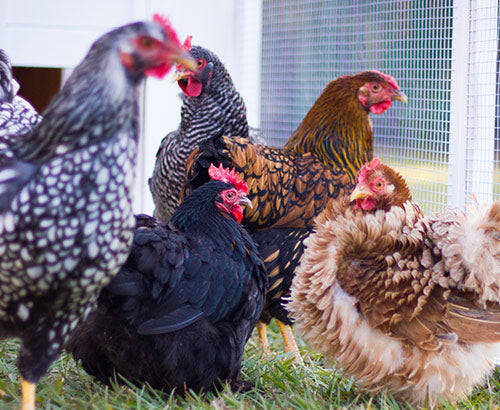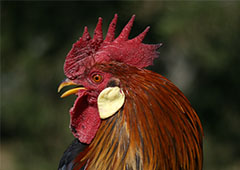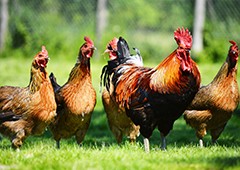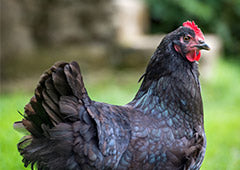Plain and simple, the answer is no! Hens are one of the most captivating creatures on the face of the earth. They are beautiful, intelligent, sensitive, affectionate, and capable of nothing short of a miracle- the creation of an egg. And, not only are these lovely ladies able to create an egg, they create and lay an egg approximately every twenty-five hours completely without the help of their male counterpart, the rooster. Unfathomable!
The benefits to having a Rooster in your flock
Now although hens have the ability to lay eggs without a rooster, a rooster is needed in order to fertilize your hens’ eggs. So, if you’d like raise chickens from your own breed lines, then you’ll need to add a handsome rooster to your backyard flock and let him strut his stuff!
Whether or not you want to breed your chickens, a rooster is a very handy guy to have around. He does play an important role within your backyard flock. Roosters, being the gallant gentlemen that they are, protect their ladies, alerting them to approaching predators such as eagles, foxes, stray dogs and cats, etc. and corralling the hens safely back into their coop. They also intervene when hens get a little too “clucky” or are too busy minding their flock mate’s business. Plus, we cannot forget the most enchanting trait of our flamboyantly feathered friend…his grand announcement each and every day that morning is here!
Is it a Rosie, or a Roger?
Sometimes, we backyard chicken keepers find ourselves pondering the “Big” question…is it a hen or a rooster? When choosing to raise new hatchlings or day old chicks, sometimes determining the sex of a chick or juvenile bird can be quite puzzling. There are basically four methods that will help you to identify the sex of your day old chick- the vent method, the feather style method, the feather rate of occurrence method, and the down color method. The vent method is complex and requires extensive training to look inside a chick’s vent and analyze the differences in sex organs. Both feather methods are much easier and simply involve spreading the chick’s wing and looking at the length of primary and covert feathers(feathers that cover the base of a chick’s primary wing feathers and protect the quill), or observing when wing feathers occur. Finally, in some breeds the downy coloring is a telltale sign of the sex of a chick. If you are hesitant to handle these fidgety babies, then just sit back and observe your peeps as they grow and mature. There are clues that you can look for. If it’s a male, look for larger and deeper red combs and wattles- combs can actually be larger than a rooster’s head and wattles will extend far below his beak, growing spurs (from about 3 months on at the earliest), shimmering feathers, as well as, longer, pointy hackle (neck) and saddle (back) feathers, and long pointy curling tail feathers. With feathers like these, I ask you, how can these boys not strut their stuff? Kudos, boys!
Most importantly, enjoy your new feathery friends and marvel as they change from week to week and grow up right before your eyes. And, if you still aren’t able to solve the riddle of “pullet or cockerel”, just wait patiently until about 5 or 6 months down the road when maturity will make itself known or until your hear that infamous first “Cock-a-doodle-doo !”
How do roosters fertilize eggs?
Roosters are an essential part of the mating process. Not just because of his seed, but also because he'll be the one to initiate the mating ritual. In short, a fertile rooster will mount a hen and touches his cloaca with hers. This romantic moment is known as a cloacaic kiss!
It all begins once the rooster has decided which hen he would like to mate with. He will perform dances for her by dragging and dropping a wing and stamping his feet. Alongside this clear grab for attention, he will also attempt to get behind the hen and ready to mount. If she enjoyed his dance and felt a deep loving connection, she will squat down so that he can mount her. Even if she wasn't impressed by his moves, he'll still attempt to mount her.
The roosters seed is usually stored in the hen's storage sac until the next egg is laid and the production of a new one begins. This allows for the developing egg to be inseminated.
Fertilized or unfertilized?
Another puzzling situation in the world of backyard chicken keeping is identifying fertilized and unfertilized eggs. How do you know if one of those lovely fresh eggs you gather each morning will hatch a fuzzy lil’ chick in a few short weeks? Well, if indeed a rooster enriches your backyard flock, then there is a strong possibility; however, only under certain conditions. You’ll need to crack the egg open though to see proof. Basically, all eggs will contain the hen’s genetic matter which appears as a pale white irregularly shaped spot. If an egg has been fertilized by a rooster, the egg will contain genetic matter from both male and female and this spot will look white in color and have a bullseye appearance. For a fertilized egg to develop into an embryo, it must be handled properly- a fertilized egg must either be stored properly indoors in a carton, in a sunlight-free, cool, dry area and then incubated for a period of twenty-one days in order for a chick to develop and hatch, or allowed to hatch underneath the warmth and comfort of a broody hen. A procedure known as candling, which doesn’t require cracking your eggs open, may help you to identify a fertilized egg. Candling involves shining a bright light directly at an egg to examine what’s inside. If an egg is in fact fertilized and an embryo is developing, by day seven of incubation, you may be able to detect a network of blood vessels encircling a dark area! Congratulations! All is developing well and in just two more weeks, you’ll be witnessing the miracle of watching a new hatchling enter the world! So, all in all, whether or not you want a rooster to add a little dazzle to your backyard flock, or you just want a spectacular sire, he will definitely spice up your life! Cock-a-doodle-do!
Whether its a noisy rooster or introducing new chickens to your flock, chickens can be trained to stop bad habits and reinforce positive ones. Although some behaviours are cute quirks for a breed, others may be a cause for concern!
Cluckily, our friends over at Chickenpedia have created an amazing Chicken Etiquette Course. This extensive online course shares useful advice on a variety of chicken behaviours. The well-structured course will also help you deal with bad behaviour and encourage positive behaviours. Keep the neighbours happy - their only complaint will be that they wish they also had chickens!
Learn how to have the best-behaved chickens in town with this beginner-friendly course. This is why I highly recommend Chickenpedia’s courses to all of my readers! They are filled with vital information that help you raise a happy, healthy flock.
Click here to check out Chickenpedia today!


















